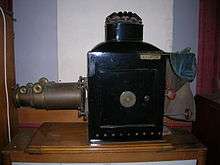Opaque projector

The opaque projector, epidioscope, epidiascope or episcope is a device which displays opaque materials by shining a bright lamp onto the object from above. A system of mirrors, prisms and/or imaging lenses is used to focus an image of the material onto a viewing screen. Because they must project the reflected light, opaque projectors require brighter bulbs and larger lenses than overhead projectors. Care must be taken that the materials are not damaged by the heat generated by the light source. Opaque projectors are not as common as the overhead projector.
Opaque projectors are typically used to project images of book pages, drawings, mineral specimens, leaves, etc. They have been produced and marketed as artists’ enlargement tools to allow images to be transferred to surfaces such as prepared canvas, or for lectures and discourses.
History
The opaque projector is a predecessor to the overhead projector. The light source in early opaque projectors was often limelight. Incandescent light bulbs and halogen lamps are most commonly used today. In the early and middle parts of the 20th century, low-cost opaque projectors were produced and marketed as toys for children.
In educational settings, the specific role of the opaque projector has been superseded by the document camera, a lighted table with a fixed video camera above it. The image from the camera is displayed using a separate projector. The document camera is also called a desktop presenter unit or opaque projector.
Types
At the beginning of the 20th century, projection was split into two classes: "If the light traverses the object, the projection is said to be diascopic, if by reflected light, episcopic."[1]
Two main classes of opaque projectors thus existed:
- the episcope, which solely projected images of opaque objects
- the epidiascope, which was capable of projecting images of both opaque and transparent images
See also
- Projector (disambiguation) for a directory of projector types.
- Telop
References
- ↑ "Lantern". Encyclopaedia Britannica (11th ed.). Cambridge, UK: University of Cambridge. 1911. Archived from the original on 6 March 2013.
External links
- Episcopes and epidiascopes, photographs of a collection.
- Historic Ross Epidiascope
- A Description of the Braun Paxiscope unit (Braun Paxiscope)
- Patent #803.385 for one of the earliest epidiascopes